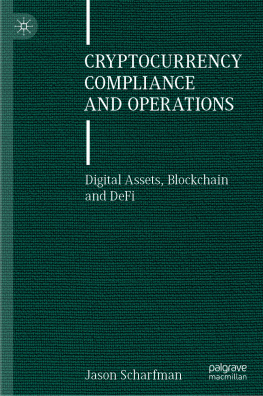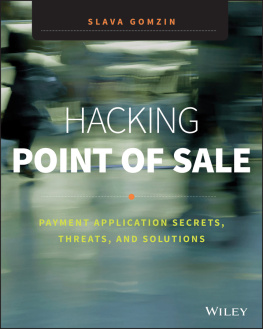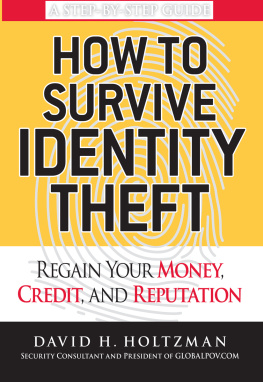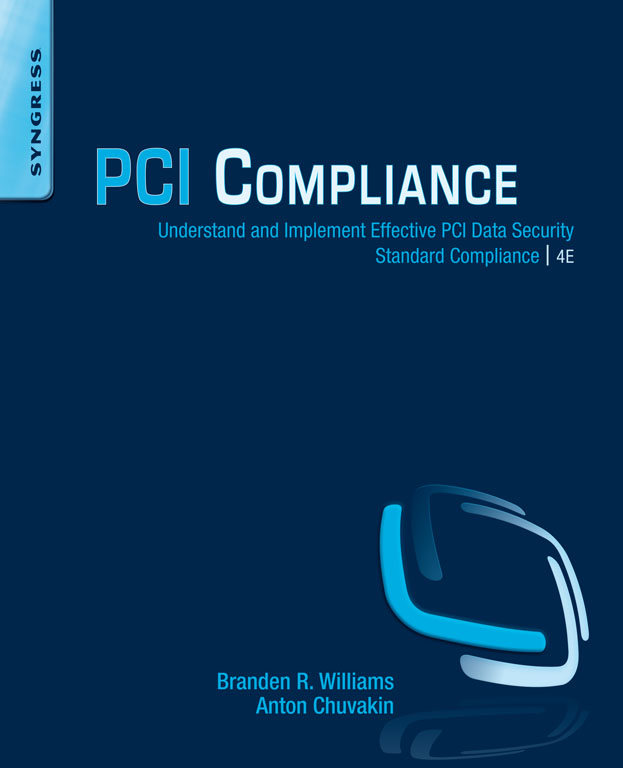PCI Compliance
Understand and Implement Effective PCI Data Security Standard Compliance
Fourth Edition
Branden R. Williams
Anton A. Chuvakin
Technical Editor
Derek Milroy
Table of Contents
Copyright
Syngress is an imprint of Elsevier
225 Wyman Street, Waltham, MA 02451, USA
Copyright 2015 Elsevier Inc. All rights reserved.
No part of this publication may be reproduced or transmitted in any form or by any means, electronic or mechanical, including photocopying, recording, or any information storage and retrieval system, without permission in writing from the publisher. Details on how to seek permission, further information about the Publishers permissions policies and our arrangements with organizations such as the Copyright Clearance Center and the Copyright Licensing Agency, can be found at our website: www.elsevier.com/permissions.
This book and the individual contributions contained in it are protected under copyright by the Publisher (other than as may be noted herein).
Notices
Knowledge and best practice in this field are constantly changing. As new research and experience broaden our understanding, changes in research methods, professional practices, or medical treatment may become necessary.
Practitioners and researchers must always rely on their own experience and knowledge in evaluating and using any information, methods, compounds, or experiments described herein. In using such information or methods they should be mindful of their own safety and the safety of others, including parties for whom they have a professional responsibility.
To the fullest extent of the law, neither the Publisher nor the authors, contributors, or editors, assume any liability for any injury and/or damage to persons or property as a matter of products liability, negligence or otherwise, or from any use or operation of any methods, products, instructions, or ideas contained in the material herein.
Library of Congress Cataloging-in-Publication Data
Application Submitted
British Library Cataloguing in Publication Data
A catalogue record for this book is available from the British Library
For information on all Syngress publications visit our web site at http://store.elsevier.com/
ISBN: 978-0-12-801579-7
This book has been manufactured using Print On Demand technology. Each copy is produced to order and is limited to black ink. The online version of this book will show color figures where appropriate.
Foreword
APT. Cybercrime. Hacktivism. PCI. Those are a few of the subjects that keep security leaders up at night. If you are wondering how PCI ended up on that short list and why it may cause bouts of insomnia, simply ask someone who has to deal with PCI DSS (Payment Card Industry Data Security Standard) assessments on a regular basis and you are guaranteed to receive strong responses. Yelling matches between security leaders and their PCI assessors over terms such as segmentation, isolation, unrecoverable, and significant change have become all too commonplace.
There is little argument that the prescriptive nature and detailed requirements of the DSS are a good guide for security professionals to benchmark and improve immature information security programs. However, the PCI DSS presents a paradox for mature programs. The narrow focus of the DSS on credit card data requires artificial boundaries and duplicate control investments. This can lead to more complex network and security architectures as well as increased hardware, software, and labor costs. It can, in certain situations, also lead to bad business risk decisions in order keep non-PCI systems out of scope of the annual assessment. It is for these reasons that PCI has become a controversial, disruptive, and insomnia-inducing influence inside many large (and some medium/small) organizations.
Even if PCI DSS assessments are nothing new to you, it would probably be a good time for a refresher course in not only the basics of the PCI standard but also the changes that will be going into effect with PCI DSS 3.0. Obviously familiarizing yourself with the changes in the standard from 2.0 to 3.0 is a great start but most likely not enough. One of the best things you can do to prepare yourself for the updated standard is to read this book cover to cover. Then re-read sections on managing the assessment scope, running the PCI assessment project as an ongoing program, and how to work well with your assessors (theyre not the enemy!). Once youve read the book I would suggest keeping it handy as a reference guide. I know that I will have this book in my office, highlighted, bookmarked, and within easy reach over the next few years as conflicts between business requirements and PCI compliance arise.
Dan Glass
Senior Manager Information Systems Security
American Airlines
Acknowledgments
PCI DSS 3.0 is here, and boy is it a doozy! Both Anton and I are very thankful that you continue to support our efforts and read our work.
This book is dedicated to my family for supporting the effort to make this work the central tome for the industry. When we started this journey, my youngest wasnt even a year old. Now shes going into Kindergarten.
Once again, we need to give a HUGE thanks to Derek Milroy for stepping up and providing great content around Windows, vulnerability management, and being the sole technical editor for this book. You will find his influence in every chapter of this edition.
And finally, to you, the reader. Whether you are in internal audit, a QSA, or simply someone responsible for some portion of PCI DSS, you live in the trenches implementing solutions every day. The bad guys will never stop, so remember to build securely!
Dr. Branden R. Williams
Chapter 1
About PCI DSS and this book
Abstract
About PCI DSS and this book explains why PCI DSS is special and what the book is about.
Information in this chapter
Who should read this book?
How to use the book in your daily job
What this book is not
Organization of the book
Summary
The Payment Card Industry Data Security Standard (PCI DSS) celebrated its ninth year (December 15, 2004) and the PCI Security Standards Council its eighth birthday (September 7, 2006) as of this writing. Most of you reading these words have probably heard about PCI DSS, worked on a project tied to PCI DSS compliance, or said a few words out loud about PCI DSS that would have earned at least one of the authors a big smack across the face from his mother. For those of you just starting with PCI DSS, we authors hope this book can be your guide to a successful end resulta sustainable compliance program that exceeds the baseline security standards set forth in PCI DSS 3.0.










